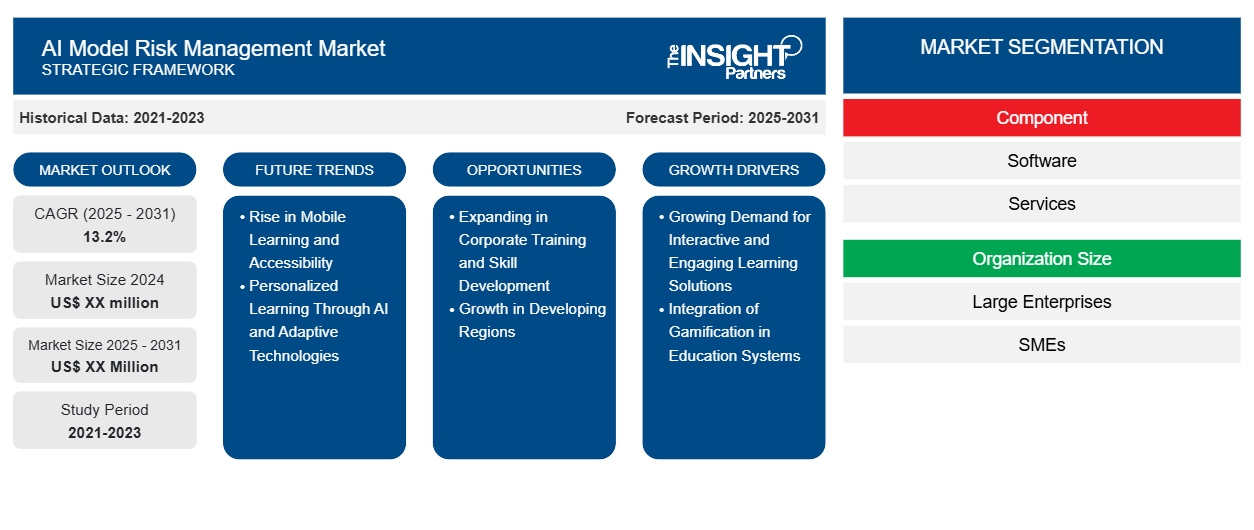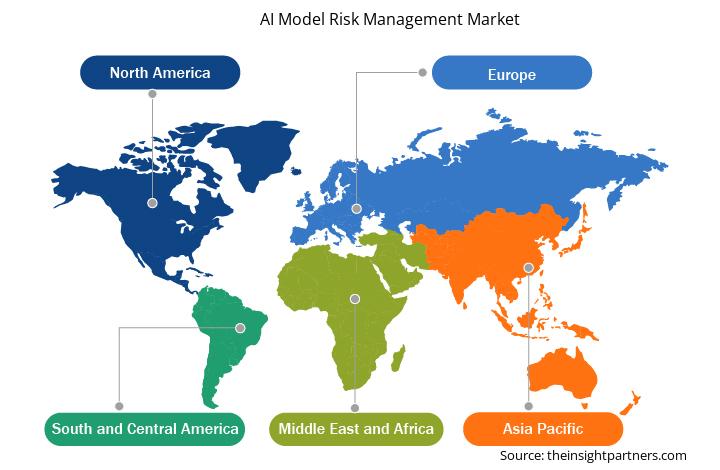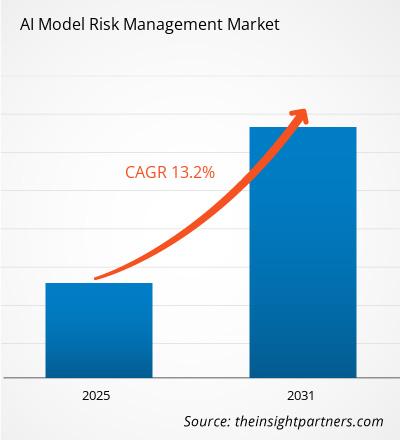من المتوقع أن يسجل سوق إدارة مخاطر نموذج الذكاء الاصطناعي معدل نمو سنوي مركب بنسبة 13.2٪ من عام 2025 إلى عام 2031، مع توسع حجم السوق من XX مليون دولار أمريكي في عام 2024 إلى XX مليون دولار أمريكي بحلول عام 2031.
يُقسّم التقرير حسب المكونات (البرمجيات، الخدمات)؛ حجم المؤسسة (الشركات الكبيرة، الشركات الصغيرة والمتوسطة)؛ النشر (السحابة، محليًا)؛ نوع المخاطر (المخاطر الأمنية، المخاطر الأخلاقية، المخاطر التشغيلية)؛ المستخدمون النهائيون (قطاعات الخدمات المصرفية والمالية والتأمين، تكنولوجيا المعلومات والاتصالات، الرعاية الصحية، تجارة التجزئة والتجارة الإلكترونية، التصنيع، قطاعات أخرى). ويُفصّل التحليل العالمي بشكل أكبر على المستوى الإقليمي والدول الرئيسية. ويُقدّم التقرير القيمة بالدولار الأمريكي للتحليل والقطاعات المذكورة أعلاه.
غرض التقرير
يهدف تقرير "سوق إدارة مخاطر نماذج الذكاء الاصطناعي" الصادر عن شركة "ذا إنسايت بارتنرز" إلى وصف المشهد الحالي والنمو المستقبلي، وأهم العوامل المحفزة، والتحديات، والفرص المتاحة. وسيوفر هذا التقرير رؤى ثاقبة لمختلف أصحاب المصلحة في قطاع الأعمال، مثل:
- مزودي التكنولوجيا/المصنعين: لفهم ديناميكيات السوق المتطورة ومعرفة فرص النمو المحتملة، وتمكينهم من اتخاذ قرارات استراتيجية مستنيرة.
- المستثمرون: إجراء تحليل شامل للاتجاهات فيما يتعلق بمعدل نمو السوق، والتوقعات المالية للسوق، والفرص المتاحة عبر سلسلة القيمة.
- الهيئات التنظيمية: لتنظيم السياسات ومراقبة الأنشطة في السوق بهدف تقليل الانتهاكات والحفاظ على ثقة المستثمرين ودعم سلامة السوق واستقرارها.
تجزئة سوق إدارة مخاطر نموذج الذكاء الاصطناعي
عنصر
- برمجة
- خدمات
حجم المنظمة
- الشركات الكبيرة
- الشركات الصغيرة والمتوسطة
النشر
- سحاب
- في الموقع
عنصر
- برمجة
- خدمات
المستخدمون النهائيون
- الخدمات المصرفية والمالية والتأمين
- تكنولوجيا المعلومات والاتصالات
- الرعاية الصحية
- التجزئة والتجارة الإلكترونية
- تصنيع
قم بتخصيص هذا التقرير ليناسب متطلباتك
ستحصل على تخصيص لأي تقرير - مجانًا - بما في ذلك أجزاء من هذا التقرير، أو تحليل على مستوى الدولة، وحزمة بيانات Excel، بالإضافة إلى الاستفادة من العروض والخصومات الرائعة للشركات الناشئة والجامعات
سوق إدارة مخاطر نموذج الذكاء الاصطناعي: رؤى استراتيجية

- احصل على أهم اتجاهات السوق الرئيسية لهذا التقرير.ستتضمن هذه العينة المجانية تحليل البيانات، بدءًا من اتجاهات السوق وحتى التقديرات والتوقعات.
عوامل نمو سوق إدارة مخاطر نموذج الذكاء الاصطناعي
- تزايد الطلب على حلول التعلم التفاعلية والجذابة: يُسهم الإقبال المتزايد على الأدوات التعليمية التفاعلية والجذابة في نمو سوق التعلم القائم على الألعاب. وتُستبدل الأساليب التقليدية بتجارب أكثر شموليةً وتفاعلية، تُعزز مشاركة الطلاب وتحفيزهم وقدرتهم على الاحتفاظ بالمعلومات. يُقدم التعلم القائم على الألعاب نهجًا ديناميكيًا وعمليًا يُلبي مختلف أنماط التعلم، مما يجعل التعليم أكثر متعةً وفعالية. وفي ظل سعي المدارس والجامعات وبرامج التدريب المؤسسية إلى إيجاد طرق مبتكرة لتحسين نتائج التعلم، يتزايد الطلب على حلول التعلم القائمة على الألعاب.
- دمج أساليب اللعب في النظم التعليمية: تدمج المؤسسات التعليمية أساليب اللعب بشكل متزايد في مناهجها الدراسية لتحسين نتائج التعلم. ومن خلال دمج عناصر مثل قوائم المتصدرين والإنجازات والمكافآت، تشجع منصات التعلم القائمة على الألعاب المشاركة الفعالة والتنافس الشريف بين المتعلمين. ويُعتبر هذا النهج اللعبي وسيلة فعالة لتعزيز مشاركة الطلاب، وتشجيع التعلم التعاوني، وتعزيز الاحتفاظ بالمعرفة على المدى الطويل، مما يدفع عجلة نمو السوق في القطاعين الأكاديمي والمؤسسي.
اتجاهات مستقبل سوق إدارة مخاطر نموذج الذكاء الاصطناعي
- ازدياد التعلّم عبر الأجهزة المحمولة وسهولة الوصول إليها: يُعدّ التبني المتزايد لحلول التعلّم عبر الأجهزة المحمولة من أبرز التوجهات في سوق التعلّم القائم على الألعاب. ومع انتشار استخدام الهواتف الذكية والأجهزة اللوحية، أصبح التعلّم عبر الأجهزة المحمولة أكثر سهولةً للمتعلمين حول العالم. تُوفّر المنصات المحمولة مرونةً تُمكّن الطلاب من التعلّم في أي وقت وفي أي مكان، مما يجعل التعليم أكثر ملاءمةً وتكيّفًا مع جداولهم المزدحمة. يُحفّز هذا التوجه توسّع تطبيقات التعلّم عبر الألعاب، لا سيما في التعليم من الروضة إلى الصف الثاني عشر، ومنصات التعلّم الإلكتروني، وبرامج التدريب للشركات.
- التعلم المُخصَّص من خلال الذكاء الاصطناعي والتقنيات التكيفية: يُعيد دمج الذكاء الاصطناعي وتقنيات التعلم التكيفي في منصات التعلم القائمة على الألعاب صياغة سوق التعلم. يُمكن للذكاء الاصطناعي تخصيص تجربة التعلم من خلال تعديل مستوى الصعوبة والمحتوى بناءً على أداء المتعلم الفردي. يُتيح هذا التوجه تعلمًا أكثر تخصيصًا وسرعةً ذاتية، مما يزيد من فعالية الألعاب التعليمية. في ظل سعي المؤسسات والمنظمات التعليمية لتوفير مسارات تعليمية أكثر تخصيصًا للطلاب، تكتسب حلول التعلم القائمة على الألعاب، المدعومة بالذكاء الاصطناعي، زخمًا متزايدًا.
فرص سوق إدارة مخاطر نموذج الذكاء الاصطناعي
- التوسع في التدريب المؤسسي وتطوير المهارات: يُمثل قطاع التدريب المؤسسي فرصةً واعدةً لسوق التعلم القائم على الألعاب. إذ تتبنى الشركات بشكل متزايد حلولاً تعتمد على الألعاب لتدريب موظفيها، لا سيما في المهارات الشخصية، وتنمية المهارات القيادية، والتدريب على الامتثال. تُوفر منصات التعلم القائم على الألعاب بيئةً تفاعليةً خاليةً من المخاطر للموظفين لتطوير مهارات جديدة وممارستها، مما يجعلها خيارًا جذابًا للشركات التي تسعى إلى تعزيز كفاءة التدريب. يوفر هذا التوجه المتنامي في مجال التعلم المؤسسي إمكانات نمو كبيرة للسوق.
- النمو في المناطق النامية: يشهد سوق التعلم القائم على الألعاب نموًا ملحوظًا في المناطق النامية، مثل آسيا والمحيط الهادئ وأفريقيا وأمريكا اللاتينية. ومع تحسن البنية التحتية التعليمية وزيادة انتشار الهواتف المحمولة في هذه المناطق، يتزايد الطلب على حلول تعليمية ميسورة التكلفة وسهلة الوصول وجذابة. يوفر التعلم القائم على الألعاب وسيلة فعالة من حيث التكلفة لتحسين جودة التعليم في المناطق محدودة الموارد، مما يوفر فرصًا كبيرة لتوسيع السوق. كما أن تصميم هذه الحلول بما يتناسب مع الاحتياجات واللغات المحلية يعزز إمكانات السوق في هذه المناطق.
رؤى إقليمية حول سوق إدارة مخاطر نموذج الذكاء الاصطناعي
قام محللو إنسايت بارتنرز بشرح شامل للاتجاهات والعوامل الإقليمية المؤثرة في سوق إدارة مخاطر نماذج الذكاء الاصطناعي خلال فترة التوقعات. كما يناقش هذا القسم قطاعات سوق إدارة مخاطر نماذج الذكاء الاصطناعي ونطاقه الجغرافي في أمريكا الشمالية، وأوروبا، وآسيا والمحيط الهادئ، والشرق الأوسط وأفريقيا، وأمريكا الجنوبية والوسطى.

- احصل على البيانات الإقليمية المحددة لسوق إدارة مخاطر نموذج الذكاء الاصطناعي
نطاق تقرير سوق إدارة مخاطر نموذج الذكاء الاصطناعي
| سمة التقرير | تفاصيل |
|---|---|
| حجم السوق في عام 2024 | XX مليون دولار أمريكي |
| حجم السوق بحلول عام 2031 | XX مليون دولار أمريكي |
| معدل النمو السنوي المركب العالمي (2025 - 2031) | 13.2% |
| البيانات التاريخية | 2021-2023 |
| فترة التنبؤ | 2025-2031 |
| القطاعات المغطاة | حسب المكون
|
| المناطق والدول المغطاة | أمريكا الشمالية
|
| قادة السوق وملفات تعريف الشركات الرئيسية |
|
كثافة اللاعبين في سوق إدارة مخاطر نموذج الذكاء الاصطناعي: فهم تأثيرها على ديناميكيات الأعمال
يشهد سوق إدارة مخاطر نماذج الذكاء الاصطناعي نموًا سريعًا، مدفوعًا بتزايد طلب المستخدمين النهائيين نتيجةً لعوامل مثل تطور تفضيلات المستهلكين، والتقدم التكنولوجي، وزيادة الوعي بمزايا المنتج. ومع تزايد الطلب، تعمل الشركات على توسيع عروضها، والابتكار لتلبية احتياجات المستهلكين، والاستفادة من الاتجاهات الناشئة، مما يُعزز نمو السوق.
تشير كثافة اللاعبين في السوق إلى توزيع الشركات العاملة في سوق أو قطاع معين. وتشير إلى عدد المنافسين (اللاعبين في السوق) الموجودين في سوق معين نسبةً إلى حجمه أو قيمته السوقية الإجمالية.
الشركات الرئيسية العاملة في سوق إدارة مخاطر نموذج الذكاء الاصطناعي هي:
- أكسنتشر
- خدمات الويب من أمازون
- شركة داتا روبوت
- ديلويت
- جوجل
- شركة آلات الأعمال الدولية
إخلاء المسؤولية : الشركات المذكورة أعلاه ليست مرتبة بأي ترتيب معين.

- احصل على نظرة عامة على أهم اللاعبين الرئيسيين في سوق إدارة مخاطر نموذج الذكاء الاصطناعي
نقاط البيع الرئيسية
- التغطية الشاملة: يغطي التقرير بشكل شامل تحليل المنتجات والخدمات والأنواع والمستخدمين النهائيين لسوق إدارة مخاطر نموذج الذكاء الاصطناعي، مما يوفر مشهدًا شاملاً.
- تحليل الخبراء: تم تجميع التقرير على أساس الفهم العميق لخبراء الصناعة والمحللين.
- معلومات محدثة: يضمن التقرير أهمية الأعمال التجارية بسبب تغطيته للمعلومات الحديثة واتجاهات البيانات.
- خيارات التخصيص: يمكن تخصيص هذا التقرير لتلبية متطلبات العملاء المحددة وتلبية استراتيجيات العمل بشكل مناسب.
لذا، يُمكن أن يُساعد تقرير البحث حول سوق إدارة مخاطر نماذج الذكاء الاصطناعي في تمهيد الطريق لفهم سيناريوهات الصناعة وآفاق نموها. ورغم وجود بعض المخاوف المُبررة، إلا أن فوائد هذا التقرير الإجمالية تفوق عيوبه.
- التحليل التاريخي (سنتان)، سنة الأساس، التوقعات (7 سنوات) مع معدل النمو السنوي المركب
- تحليل PEST و SWOT
- حجم السوق والقيمة / الحجم - عالمي، إقليمي، بلد
- الصناعة والمنافسة
- مجموعة بيانات إكسل
التقارير الحديثة
تقارير ذات صلة
شهادات العملاء
سبب الشراء
- اتخاذ قرارات مدروسة
- فهم ديناميكيات السوق
- تحليل المنافسة
- رؤى العملاء
- توقعات السوق
- تخفيف المخاطر
- التخطيط الاستراتيجي
- مبررات الاستثمار
- تحديد الأسواق الناشئة
- تحسين استراتيجيات التسويق
- تعزيز الكفاءة التشغيلية
- مواكبة التوجهات التنظيمية




















 احصل على عينة مجانية ل - سوق إدارة مخاطر نموذج الذكاء الاصطناعي
احصل على عينة مجانية ل - سوق إدارة مخاطر نموذج الذكاء الاصطناعي